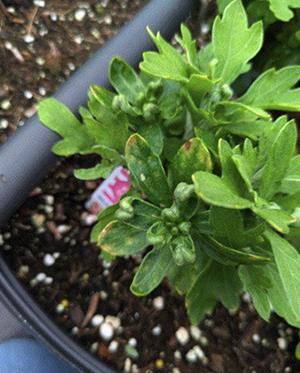We’re circling back on an issue our Technical Services team has covered many times in the past (even earlier this year) because the questions keep coming as temps stay high this summer — crown budding and how to avoid it when producing mums in the hottest part of the year.
Problem: Over the last couple weeks, a LOT of growers have reached out about premature budding (also known as “crown budding”) in their mums. After going through the diagnostic process with each grower, the likelihood that cool night temps spurred reproductive growth prematurely has been very slim. So, what else can cause this disorder when it’s been so hot for the last month or so? Low mineral nutrient availability!
Nick’s Tip
Crown bud formation is a response to accumulated physiological stress factors like cool night temps, drought stress and insufficient mineral nutrition. While unseasonal cool night temps have the most profound effect on crown budding, low mineral nutrient availability is a close second. Keep the following in mind if your mum crop has started to develop crown buds in the last week or so.

Is Your Substrate EC Low?
As I’ve mentioned in the past, mums need higher mineral nutrient levels than many spring bedding plants. Target substrate EC (electrical conductivity; then measure fertilizer/soluble salt concentration in your soil) should be around 3.0 mS/cm (via the pour-thru method) during the first half to two-thirds of the crop cycle, during active vegetative growth. If you’ve seen crown buds form and you haven’t checked substrate EC recently, this should be your first step!
• If EC is about 2.0 (or below), give the crop a “hot shot” of water-soluble fertilizer (WSF) at about 350–400 ppm N. Check EC again in a day or two and feed again if the value is still below 3.0 mS/cm.
• Ensure that the entire soil column is fully wetted with fertilizer solution whenever you apply WSF. If media is on the dry side when you feed, you may need to “pulse” fertigate (run drippers for about 10 minutes at a time and allow them to sit for 10 to 20 minutes between pulses) to keep ensure the solution doesn’t just channel out the bottom of the pot.
• To cover up crown buds, it’s best to use a more ammoniacal nitrogen (N)-based fertilizer like 20-10-20. Ammonia-form N and higher concentrations of phosphorous (P) will help axillary shoots push out from below the crown buds and fill in more rapidly.
• Once new shoots have sufficiently covered the crown buds, you can reduce P concentrations slightly and switch back to a more nitrate-based fertilizer formulation, if that is your normal preference (like if your water has low alkalinity and you generally need to avoid acidic fertilizer formulations).
• Controlled-release fertilizer (CRF) can be a good source of mineral nutrients for your mums long-term. However, an extra top-dress with CRF is not a good strategy to quickly elevate EC when it has gotten so low that crown buds form.
Be sure to check the substrate EC weekly if low nutrition caused crown buds to form in your crop! While it can be tempting to dial back fertilizer applications to reduce input costs, that’s not a good strategy if your goal is to produce a high-quality mum.
Manage the Buds … Or Don’t?
The next question many growers have asked me is: Should I pinch the crop or treat with ethephon? The short answer is, don’t waste your time and labor on crown buds.
• Crown buds are not strong “sinks” for energy, which is why they are often very small and rarely develop all the way. As such, if your crop has sufficient mineral nutrients to support good growth, is not under stress from other environmental factors, and does not have to contend with disease pressure, there is no real need to pinch or disbud.
• It’s easy enough to cover crown buds up with a good, hard fertilizer push and flush of new vegetative shoots. Removal of leaf and stem tissue will only set the crop back and potentially open the door for pathogen pressure at the pinch sites, so the risk-to-benefit equation does not really work out in favor of pinching or disbudding.
• Some varieties of mums are very sensitive to ethephon (e.g. Florel and Collate) and flowering delay or reduced growth may occur if applied at this point in the crop cycle.
Early-season applications at lower concentration (250–500 ppm) are okay to combat cool-night crown budding and generally safer, but many mum breeders will tell you to avoid ethephon applications entirely.
Older genetics are generally more tolerant of ethephon, but there is no guarantee that delay to first color will not occur when you apply ethephon at this point in the crop cycle.
• Consider the labor requirement and cost, as well. Unless your team really needs a project or something to do (doubtful), your team’s labor efforts could be easily spent elsewhere. Reduction of pest and disease pressure via mowing and weed whacking the perimeter, or removal of plant debris in your mum pad would pay much higher dividends—with respect to time spent protecting crop quality.